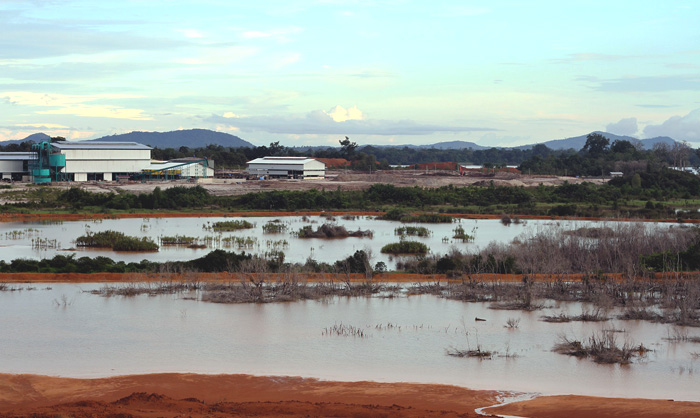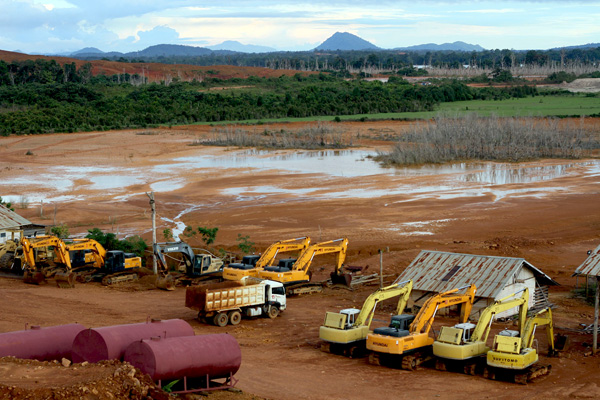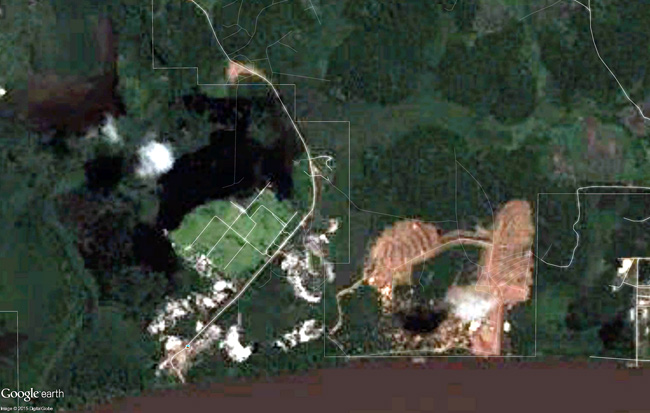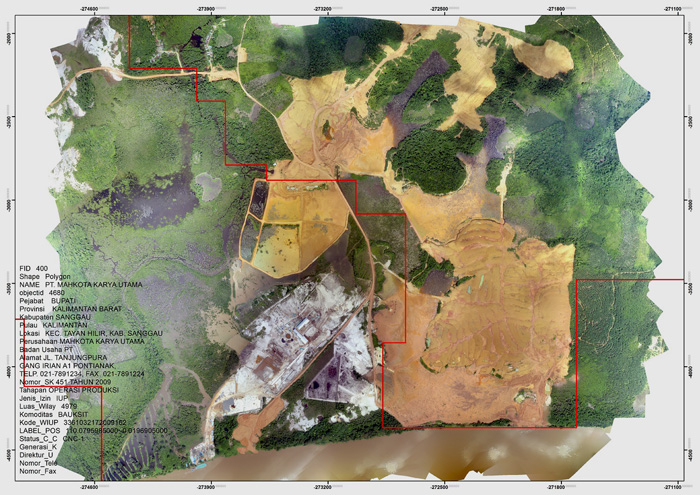
21 June 2015, Andi Fachrizal, Sanggau, West Kalimantan
Far from being luxurious, the office stands simply on Jalan Tanjungpura Gang Irian No A1 Pontianak. Only occupying a narrow shophouse, that’s where the management of PT. Mahkota Karya Utama (MKU) plays a role in the bauxite mining sector.
Unlike in Sejotang Village, Tayan Hilir District, Sanggau Regency, where this company operates. The luxury of his office is like creating a new civilization in the middle of the quiet interior of West Kalimantan.
The Dayak Tobag people who live in Sejotang Village said that the PT. MKU stands around Semenduk Lake. But the 41.5-hectare lake remains only a name. Its form has turned into a mound of bauxite mining residue. The extractive industry has snatched it away since 2011.
In fact, long before it started operating, Semenduk Lake was the lifeblood of the residents of Sejotang and the surrounding villages. Fishermen can find fish every day to meet their family’s food needs.
PT. MKU entered the Sejotang Village area and socialized with residents in 2010. With the approval of the villagers under various conditions, this mining company began operating in 2011.
“We did not expect that the company would stockpile Lake Semenduk. At that time the lake was still in dispute with Desa Kawat. The neighboring village claims this lake belongs to them,” said Ng Liefa, Head of Semenduk Hamlet, Wednesday (10/6/2015).
This statement was made by Liefa when journalists and activists from the Gemawan Institute and the New Perspective Foundation visited the lake which has now become a bauxite mound. A number of researchers from the Swandiri Institute also attending to help people carry out participatory mapping with the help of drone technology (unmanned aircraft).
Since it became a dispute, Lake Semenduk finally returned to the residents of Sejotang Village in 2014. However, its condition is no longer in its normal shape. The community is greatly disadvantaged because there is only bauxite waste.
The head of Sejotang Village, Pius Tomi, understands the villagers’ frustration. According to him, Semenduk Lake is a stretch of small lakes. In the past, people rely their economy on fishing in this lake.
Around the 1980s, Semenduk Lake was included in the administrative area of Sejotang Village. At that time, the number of villages in Tayan Hilir District was quite large, reaching 85 villages.

As it progressed, the government finally did regrouping and left 15 villages. There was a change in village boundaries. In the end, Semenduk Lake which previously geographically entered Sejotang village switched to Wire Village with the village border being the Semenduk River.
The problem, said Tomi, was that the Sejotang community did not accept the village boundaries. The reason is simple. Since a long time ago, this lake has been controlled by the residents of Dusun Semenduk which derived from the name of the hamlet, Semenduk.
“Finally, we will take care of the village boundary demarcation case. The inter-village dispute should have been resolved in 1992. It’s just that the problems don’t stop there. There are still residents who claim this lake as a private territory. The dispute continues, “explained Tom.
After 20 years, in March 2012, Pius Tomi was elected as the village head. The first step he took was working on was to convey to the people that the lake must be fought for. Finally, in December 2014, Semenduk Lake returned to Sejotang Village.
“Unfortunately, we are too late. With these conditions, the village government will work with customary institutions to find the right solution. We have suffered greatly, “he said.
When this lake was still there, explained Tomi, it was very easy for people to find fish. Both in the dry season and rain. But now his condition has completely changed. The lake is gone, people’s lives are getting more and more difficult.
Tomi admitted, residents do not necessarily lose their livelihoods. Because they work not only as fishermen but they also live as farmers in the fields, rubber, and so on. However, a small part of the community depends on the lake. Especially the residents of Dusun Semenduk, who have always lived as fishermen.
Seeing conditions like now, residents finally switched to carving rubber and became coolies. Some of them migrate to hope for luck. Currently, the number of residents in Sejotang Village reaches 1,928 people or 519 families. The residents are spread across seven hamlets with a total area of 6,500 hectares.

Sengkarut CSR dan reclamation
Pius Tomi regrets the management of the distribution of Corporate Social Responsibility (CSR) of PT. MKU. “We admit that the company contributed to this village. But the community is required to submit a proposal first like the construction of houses of worship. That too cannot be fully helped as it would take at least 50 percent of the total needs,” he said.
The company actually identified the needs of villagers and provided voluntary assistance, not encouraging people to beg through proposals, said Tom.
The same goes for the company’s promise to build a bridge. Until the company stopped operating as a consequence of the smelter policy, and in the end, the promised bridge was never completed.
The post-mining reclamation is also concerning. Tomi thinks there is something wrong with this company. “I have always disagreed if the reclamation fund, which amounted to Rp. 5 million per hectare, would be handed over to the landowner,” he said.
Tomi said that the company and the owner of the land reclaiming the former mine should recover to its original state. Not by giving a certain amount of money to the landowner, then he is considered to have carried out the reclamation obligation.
“Now where are the results? Money in the amount of Rp. 5 million became completely useless. People are confused about how to plant in ex-mining areas. Meanwhile, the ground surface has been transported to the bauxite wash,” said Tomi.

PT. MKU denies
Area Planning Staff PT. MKU, Ihsan Mulyadi denied all accusations by residents that were addressed to his company. “We never fill the lake at all. As far as I know, Sejotang residents mean a lake as a swamp,” he said when Mongabay Indonesia visited his office in Pontianak, Thursday (18/6/2015).
The atmosphere at the PT. MKU looked quiet at that time. There is no meaningful activity. There were only Ihsan Mulyadi and a few company administration staff. The General Manager, Putra Djaja was not there.
“We believe it is not right that we are accused of filling up the lake. It should be studied first, what is meant by a lake. In Sejotang, our analysis found out that it is a swamp. They actually formed a lake when we built the dam. The Amdal is there. It is impossible for us to dare to stockpile the lake, “said Ihsan.
He said, the naming of the lake was born from the local community, even though what was there was actually a swamp. “All company policies in the area of operation have been approved by the community. Including reclamation. According to the initial agreement, we only provide a certain amount of money, and the people themselves will carry out the reclamation,” he said.

The company is misleading
Swandiri Institute researcher, Arif Munandar assessed the management of PT. MKU only defended itself by saying it did not convert the lake. “We can see it on the Google Earth 2010 map. The area where the company washes bauxite, it is clear that the hydraulic lake is on the riverbank,” he said after breaking the fast with the KPK Leadership Candidate Committee (Pansel) Team in Pontianak, Friday (19/6/2015) .
According to Arif, PT MKU had the courage to convert Semenduk Lake into a bauxite washing area. As a result, now what appears is the canal blocks. when the place was supposed to be outside the concession permit he controlled.
The former Executive Director of Walhi Jambi questioned the status of Clear and Clean (CnC) that PT. MKU. “The case of PT MKU in Sejotang has opened a new curtain on the status of CnC. It turns out that the status only seems acceptable on paper. Administratively it is good, even though the reality on the ground is inversely proportional to that,” he said.
Arif also commented on the post-mining reclamation procedures. According to him, it is not a matter of the nominal Rp. 5 million per hectare that the company must prepare. However, in regards to how the companies can take part with the community in efforts to restore environmental conditions.
Source: http://www.mongabay.co.id/2015/06/21/danau-pertambangan/